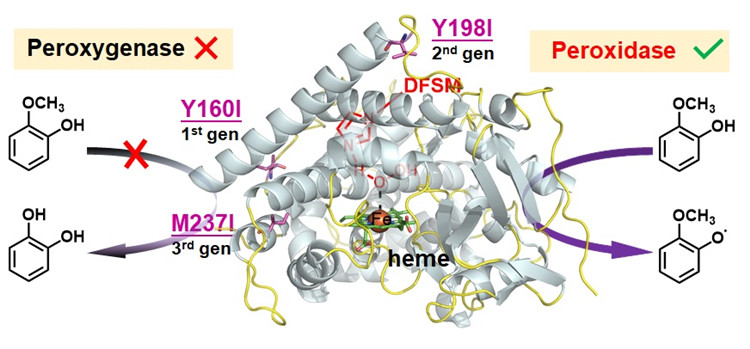Researchers Convert P450 Peroxygenase into Peroxidase via Mechanism-guided Protein Engineering
Enzyme catalysis is a promising green solution for producing pharmaceuticals, fine chemicals, and biofuels. However, exploring their catalytic promiscuity to expand and enhance the capabilities of enzymes remains challenging.
A research team led by Dr. CONG Zhiqi from the Qingdao Institute of Bioenergy and Bioprocess Technology (QIBEBT) of the Chinese Academy of Sciences (CAS) applied a protein engineering strategy of mutating redox-sensitive residues that enables the peroxygenase system to achieve efficient peroxidase activity.
The study was published in ACS catalysis on June 28.
In their previous study, the researchers reported a unique H2O2-dependent cytochrome P450 system driven by a dual-functional small molecule (DFSM), which exhibited highly efficient peroxygenase function rather than peroxidase activity. "However, the catalytic peroxidase functionality of P450s has not yet been fully explored," said Dr. CONG.
To expand the catalytic promiscuity of the DFSM-facilitated P450-H2O2 system, the researchers analysed three possible catalytic pathways in the system, and inferred that the intrinsic competitive oxidation of redox-sensitive residues may be the main reason to prevent its peroxidase function.
They identified hotspots of redox-sensitive residues, and then used a small number of logically chosen amino acids to exchange the residues at the hotspots.
After combining several-round iterative mutations of redox-sensitive residues at different sites, the researchers realized peroxidase function of the DFSM-facilitated P450-H2O2 system with efficient one-electron oxidation activity toward various substrates. This system attained the best peroxidase activity of any P450 reported to date, and rivaled most natural peroxidases.
The collaborative simulation study with Dr. WANG Binju of Xiamen University showed the possibility for the origin of peroxidase activity in the DFSM-facilitated P450BM3-H2O2 system from either the removal of the redox-sensitive residues to eliminate their competitive oxidations or the alteration of substrate orientation after protein engineering.
"The study provides new insights and strategies relevant for expanding the catalytic promiscuity of P450s through combining the effects of protein engineering and exogenous molecules," said Dr. CONG.

Functional conversion of peroxygenase to peroxidase in DFSM-facilitated P450BM3- H2O2 system. (Image by MA Nana)
(Text by MA Nana)
Contact:
CHENG Jing
Qingdao Institute of Bioenergy and Bioprocess Technology, Chinese Academy of Sciences
Tel: 86-532-80662647/80662622
E-mail: chengjing@qibebt.ac.cn